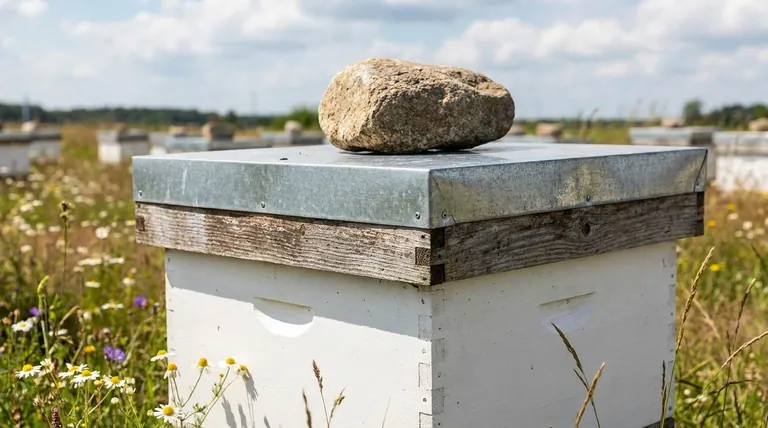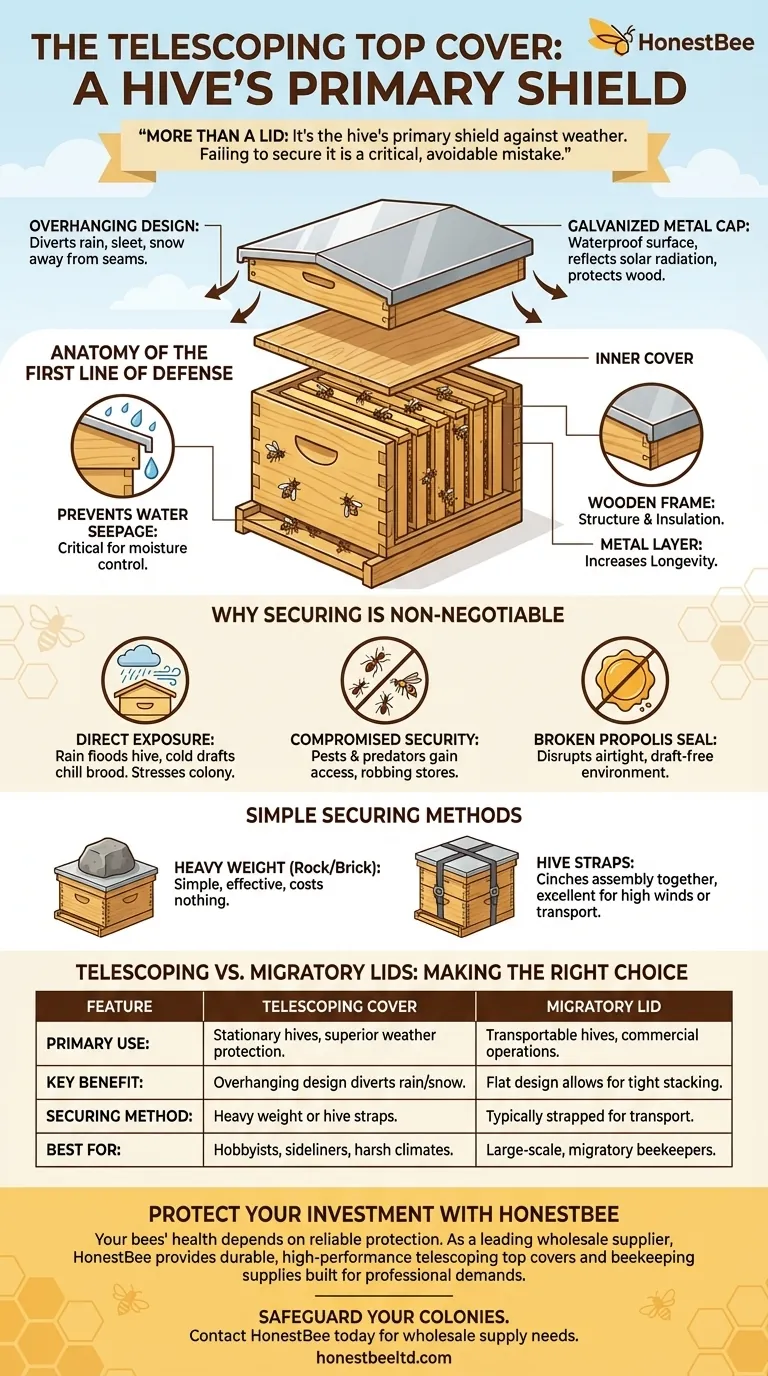At its core, a telescoping top cover is a protective lid for a beehive, specifically designed to overhang the top hive body by an inch or two on all sides. This overhang is its defining feature. It must be secured with a weight, like a brick or heavy rock, to prevent strong winds from dislodging it and exposing the colony to the elements.
The telescoping top cover is more than just a lid; it is the hive's primary shield against weather. Its overlapping design creates a weather-resistant seal, and failing to secure it is one of the most critical and easily avoidable mistakes a beekeeper can make.

The Anatomy of a Hive's First Line of Defense
To understand why securing the cover is so important, you must first appreciate its design. It is engineered specifically to solve the problem of water and weather intrusion.
The "Telescoping" Overhang
The key feature is the "telescoping" or overhanging edge. Unlike a simple flat lid, this design ensures that rain, sleet, and melting snow are directed away from the hive's seams.
This prevents water from seeping between the top cover and the inner cover or hive body below, which is a common point of failure for moisture control.
Durable, Weather-Resistant Construction
Telescoping covers are typically built with a wooden frame for structure and insulation.
This frame is almost always capped with a sheet of galvanized metal. This metal layer provides a waterproof surface, reflects solar radiation, and significantly increases the longevity of the cover by protecting the wood from rot.
Why Securing the Cover is Non-Negotiable
A loose top cover is a critical vulnerability for the entire colony. The simple act of placing a weight on top mitigates several serious risks.
Direct Exposure to Weather
The most immediate danger is exposure. If wind blows the cover off, rain can flood the hive, and cold drafts can rapidly chill the brood nest.
A wet and cold colony must expend enormous energy to regulate its temperature, stressing the bees and potentially leading to death, especially during winter.
Compromised Hive Security
An open hive is an invitation to pests and predators. Ants, wasps, and other intruders can easily gain access, robbing honey stores and harassing the bees.
Furthermore, bees use propolis (a resinous substance) to seal the gap between the cover and the hive body, creating an airtight, draft-free environment. A dislodged cover breaks this vital seal.
Simple Securing Methods
The most common method is placing a heavy rock or brick on top of the cover. It is simple, effective, and costs nothing.
For areas with very high winds or for beekeepers who move their hives, hive straps are an excellent alternative that cinches the entire hive assembly together.
Understanding the Trade-offs: Telescoping vs. Migratory Lids
The telescoping cover is the most popular choice for stationary hives, but it's not the only option. Its main alternative is the migratory lid.
Superior Weather Protection
The telescoping cover offers unmatched protection from precipitation. Its overlapping design is ideal for beekeepers in climates with significant rain or snow. It is the default choice for hobbyists and sideliners whose hives remain in one location year-round.
Cost and Portability
The migratory lid, in contrast, sits flush with the sides of the hive body. It is less expensive and lighter, and its flat top and sides allow hives to be stacked tightly together on pallets.
This design makes it the preferred choice for large-scale commercial beekeepers who frequently transport their colonies for pollination contracts. The trade-off is significantly reduced protection from rain.
Making the Right Choice for Your Apiary
Your choice of cover depends entirely on your beekeeping goals.
- If your primary focus is colony health in a stationary apiary: The telescoping top cover is the superior choice for its robust weather protection.
- If your primary focus is ease of transport and minimizing cost for a large number of hives: The migratory lid is the more practical option, with the understanding that hives may require additional shelter from severe weather.
Ultimately, protecting your colony from the elements is a fundamental responsibility, and the telescoping cover is the most reliable tool for that job.
Summary Table:
| Feature | Telescoping Cover | Migratory Lid |
|---|---|---|
| Primary Use | Stationary hives, superior weather protection | Transportable hives, commercial operations |
| Key Benefit | Overhanging design diverts rain/snow | Flat design allows for tight stacking |
| Securing Method | Heavy weight (brick/rock) or hive straps | Typically strapped for transport |
| Best For | Hobbyists, sideliners, harsh climates | Large-scale, migratory beekeepers |
Protect Your Investment with the Right Equipment
Your bees' health depends on reliable protection from the elements. As a leading wholesale supplier to commercial apiaries and beekeeping equipment distributors, HONESTBEE provides durable, high-performance telescoping top covers and other essential beekeeping supplies built to withstand harsh conditions.
Let us help you safeguard your colonies. Our equipment is designed for the demands of professional beekeeping, ensuring your hives remain secure and productive.
Contact HONESTBEE today to discuss your wholesale supply needs and secure the best equipment for your apiary.
Visual Guide

Related Products
- Long Langstroth Style Horizontal Top Bar Hive for Wholesale
- Professional Insulated Winter Hive Wrap for Beekeeping
- Professional Drop-Style Hive Handles for Beekeeping
- Wholesales Dadant Size Wooden Bee Hives for Beekeeping
- Inner Beehive Cover for Beekeeping Bee Hive Inner Cover
People Also Ask
- What are the technical and maintenance characteristics of the Top Bar Hive in commercial beekeeping? Key Insights
- What are the most popular types of hives besides the Langstroth? Top Bar & Horizontal Hives Explained
- What are the ergonomic and management advantages of Horizontal Top-Bar Hives? Modern Beekeeping with Less Strain
- What are the box management requirements for a top bar hive vs. Langstroth? Choose Your Hive Strategy
- What are the advantages of a top bar hive? Simpler, Bee-Centric Beekeeping for All



















